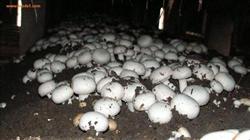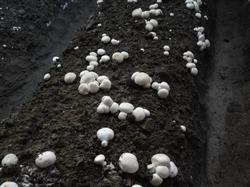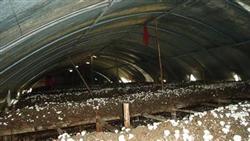Disease Control measures of Pleurotus ostreatus

The principle of disease control: give priority to prevention, with equal emphasis on prevention and control. 1. Rot disease: fungal disease, mainly characterized by the appearance of white hyphae as thin as spider silk on the overlying soil layer of the mushroom bed, which grows irregularly and shows a spider web. The infected mushroom body basically stops growing and gradually turns brown, soft and rotten. Prevention and control measures: deal with soil-covered materials to prevent disease before sprouting. Drug treatment of mushroom shed, generally can be used to blanket spray mushroom shed, in order to completely kill the pathogen, sealed for 2 days can be used. Keep the temperature of the shed above 12 ℃ and the humidity below 90%. If the disease is found, dig and clean up measures should be taken immediately. two。 Brown spot: the main symptoms are brown or soil brown spots of different sizes on the surface of the infected mushroom body. With the extension of time and the aggravation of the disease, the spots gradually expand, and a white to gray depression occurs from the spots. The most important feature of the disease is that the diseased mushrooms are non-sticky, not rotten, not smelly, and finally dry and die. Control measures: refer to the prevention and control measures of mushroom rot. 3. Red root mushroom: the main reason is bacterial infection, which can be sprayed with mushroom disinfectant solution, but sometimes because the base material is decomposed and used for a long time, the pH value decreases seriously, or when the high temperature disposable water is too heavy and too urgent, this phenomenon can also occur. Treatment measures: spray 2% lime water supernatant to the border surface, increase the pH value of the base material to about 8, and avoid pouring water at one time. 4. Rust spot mushroom: the rust-colored spots on the mushroom body have a serious impact on its commodity quality, mainly due to bacterial infection caused by improper management, such as excessive humidity in the shed, the accumulation of small water droplets on the mushroom body, and the ventilation in the greenhouse can not make it evaporate in time, if the time is a little longer, it is likely to cause this kind of disease. Treatment measures: strengthen ventilation, space spray so that there are small water droplets on the mushroom body, should be forced ventilation, so that the water droplets evaporate within 1-2 hours, and spray mushroom disinfectant solution. 5. Mycelium does not eat food: the reason is that strain degeneration, aging, poor adaptability, weak vitality; or strain transportation to accept more than 36 ℃ of high temperature or exposure, or too heavy ammonia in the base material to inhibit strain germination. Treatment measures: change the bacteria; when the ammonia is too heavy, shake the material loose, spray 2% lime water, or spray clean water directly, bring the ammonia into the bed-based soil, and at the same time strengthen ventilation, so that the ammonia in the space is discharged with the wind, and sow again when normal. 6. Mycelium shrinkage: the reason is that the base material is fermented unevenly, the heat is produced in the material, or the paving material is too thick, and the water content of the base material or soil covering material is on the high side. Treatment measures: turn the material on the bed base, pick out the unfermented mass of manure raw meal; strengthen ventilation and stop using water.
- Prev

Planting techniques of Pleurotus ostreatus
Pleurotus ostreatus has the characteristics of good quality, good taste, low investment and high benefit, and has a broad market prospect, with an economic benefit of 12000 yuan per 667m2. Its cultivation techniques are as follows: first, prepare culture materials and formulations, according to the calculation of cultivation 100m2, it is necessary to prepare high quality dry wheat straw 1500kg, dried cow and horse manure 600kg, phosphate fertilizer 50kg.
- Next

Key points of planting techniques of Pleurotus ostreatus in greenhouse
1. The specifications of the greenhouse: 20 meters long and 12 meters wide, covering an area of 1.2mu (including mixing yard, living room, road, etc.) to build eight eight-story bamboo frames, with a planting area of 1000 square meters. Second, culture material formula (1000 square meters): Rice straw 22500 kg, cow dung 3000 kg, vegetable cake 1000 kg, compound fertilizer 400kg, urea 1.
Related
- Fuxing push coffee new agricultural production and marketing class: lack of small-scale processing plants
- Jujube rice field leisure farm deep ploughing Yilan for five years to create a space for organic food and play
- Nongyu Farm-A trial of organic papaya for brave women with advanced technology
- Four points for attention in the prevention and control of diseases and insect pests of edible fungi
- How to add nutrient solution to Edible Fungi
- Is there any good way to control edible fungus mites?
- Open Inoculation Technology of Edible Fungi
- Is there any clever way to use fertilizer for edible fungus in winter?
- What agents are used to kill the pathogens of edible fungi in the mushroom shed?
- Rapid drying of Edible Fungi

